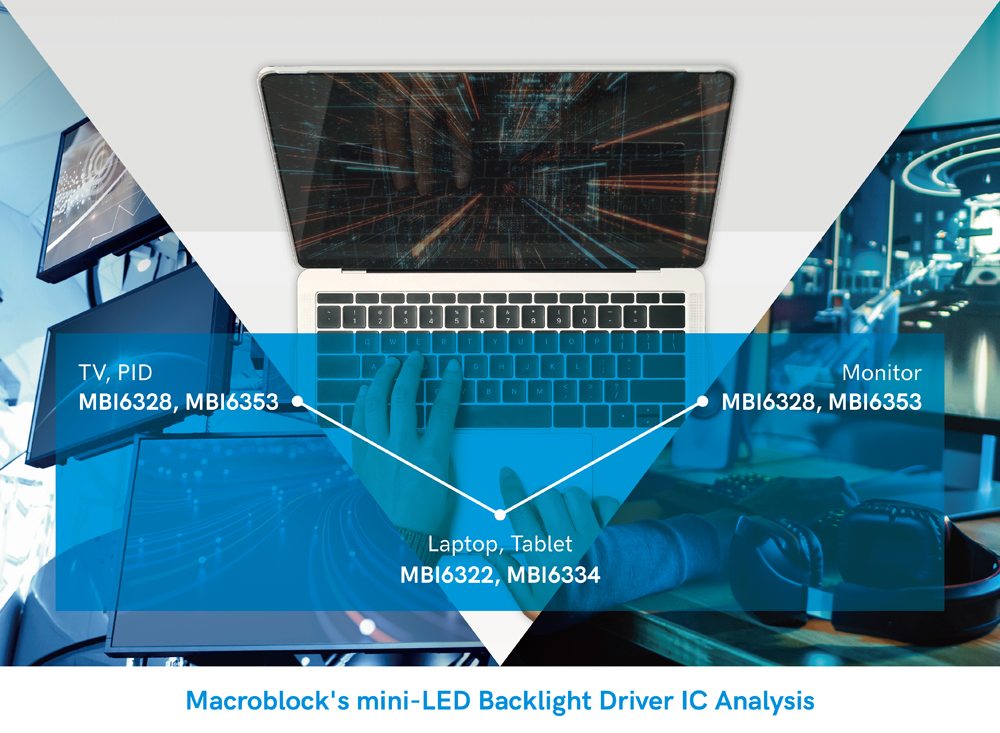CLOSE
Search for “” keywords, total search results
CLOSE
Search for “” keywords, total search results
2021.March

The hottest news recently is that the new generation of MacBook and iPad will be launched soon. It is exciting that Apple’s adoption of mini-LED backlight technology will boost the sales of high end products. Macroblock has been working in the LED backlight market for a long time and will launch new LED backlight driver ICs, MBI6334 and MBI6353 in the second quarter of 2021, which are expected to spark widespread discussion in the display industry. Macroblock’s LED backlight driver ICs will be introduced comprehensively in the following paragraphs, including common features and features based on different design architectures.
Common Features 1: Local Dimming to improve image contrast and refine image details such as HDR.
Corresponding ICs: MBI6353, MBI6334, MBI6328, MBI6322
The difference between mini-LED backlight technology and traditional LCD backlight is that the former can achieve "local dimming" result. That is, the light sources for backlight are divided into hundreds or thousands of LEDs where light sources can be controlled individually by zones from 100% brightness to completely shut down in dark area of the image. Therefore, the local diming function of hundreds to thousands of zones achieved by mini-LED backlight technology can improve image contrast and deliver HDR experiences.
Common Features 2: The Number of Driver ICs is Reduced, which simplifies PCB design and board layers, reduces costs and PCB failures, and indirectly improves overall yield.
Corresponding ICs: MBI6353, MBI6334, MBI6328, MBI6322
Mini-LED backlight helps LCD monitors achieve HDR image specifications but the higher the number of zones, the number of driver ICs and wires used doubles and the cost rises. At this time, driver ICs with high scan function can effectively solve the problem. A single IC can drive a larger number of LEDs than before, which can simplify PCB designs and board layers, reduce costs and PCB failures, and indirectly improve overall yield.
Common Features 3: Flexible Control of Black Screen Insertion, in addition to the black screen insertion function to reduce the blurring that occurs when displaying moving images; it can also flexibly arrange the time and sequence of inserting the black screen on demand.
Corresponding ICs: MBI6353, MBI6334, MBI6328, MBI6322
Design Architecture 1: The MOSFET is independent of the driver ICs and controlled by the driver ICs.
Corresponding ICs: MBI6353, MBI6334
Features:
1.1 MBI6353 with heavy current is suitable for the designs of light boards with many parallel LEDs and good for medium and large size LCD displays.
1.2 MBI6334, which does not require an external microprocessor (MCU) to control the scan signals, saves the complicated process of programming software.
1.3 MBI6334 uses a long BGA package and complies with the VESA (Video Electronics Standards Association) recommendations for the size of notebooks and timing control circuit boards. It is especially suitable for narrow circuit boards and good for small and medium-sized LCD displays.
1.4 There are microprocessors or timing control ICs available on the market for different designs.
Design Architecture 2: The MOSFET is independent of the drive ICs, and is not controlled by the drive ICs.
Corresponding ICs: MBI6328
Features:
2.1 The zone numbers for local dimming reach 1,000 or more, delivering HDR experiences.
2.2 High voltage, suitable for light board designs with many LEDs in series and good for medium and large size LCD displays.
2.3 There are currently compatible microprocessors on the market.
Design Architecture 3: The MOSFET is built in the driver ICs and controlled by the driver ICs.
Corresponding ICs: MBI6322
Features:
3.1 Highly integrated design: Integrate peripheral components, MOSFET into the driver ICs, simplifying PCB designs and board layers, reducing cost and PCB failures, and indirectly improving overall yield.
3.2 Peripheral components, wires and even PCB layers are reduced, which greatly shortens the review time for R&D layout and wiring, and accelerates the commercialization timeline.
3.3 Highly integrated design, suitable for small and medium size LCD displays.
3.4 There are appropriate timing control ICs on the market.
TrendForce estimates that the price competitiveness of mini-LED will surpass that of OLED in 2022, and the output value in 2024 is expected to reach 4.2 billion US dollars. With the advent of Apple's mini-LED backlight products, the impact and changes of mini-LEDs on displays will speed up the penetration of mini-LED backlight products in the near future.